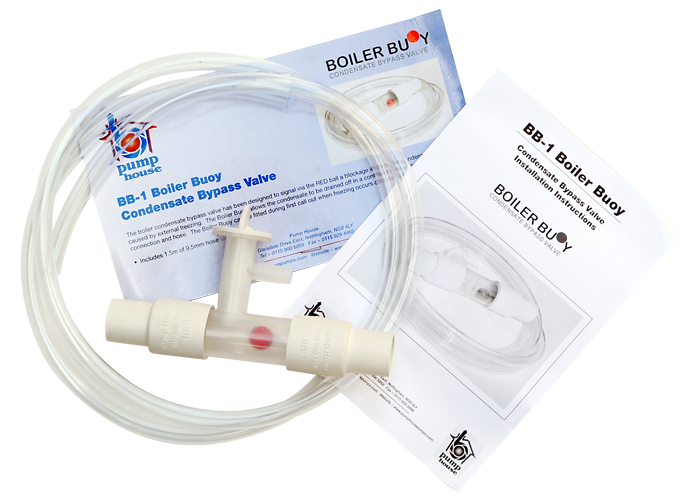The Boiler Buoy
Pat Pending GB2480335A
British Standards, Building Regulations and boiler manufacturers’ installation instructions currently allow condensate drainage pipes to be located either internally or externally, or a combination of these. HHIoC documents, a link to which can be found on the Further Information page, give guidance on how to install the condensate drainage pipes in order to reduce the possibility of freezing. However this guidance may not be sufficient to prevent freezing in extreme conditions of the type recently experienced in the UK – with widespread and prolonged very low temperatures.

Where the only option is an external termination, the Boiler Buoy Condensate Bypass Valve has been designed to signal, via a red marker, any blockage in the boiler condensate pipe caused by freezing. After experiencing extreme weather conditions in the UK, it is noticeable that occurrences of boiler drainage pipes freezing have become more frequent. This can cause a boiler to lock out and can leave a home without heating and in some cases, boiler damage, which may lead to expensive repair bills.
The Boiler Buoy is the Pump House solution, which allows the engineer or householder to drain off the condensate in a controlled way using the valve connection and hose. This easy to fit, low cost solution can be fitted during first install, emergency call outs or whilst performing annual service visits. Once fitted, this product will ensure that the boiler and heating of the property can be maintained during cold weather conditions.
An alternative to the Boiler Buoy is Trace Heating, which takes the form of an electrical heating element running in physical contact along the length of a pipe. The pipe must then be covered with thermal insulation to retain heat losses from the pipe. Heat generated by the element then maintains the temperature of the pipe, which uses energy whilst in operation with certain devices using as much as 100kw per year, if left in standby mode.
A Condensate Pump can also be adopted, which usually run intermittently and have a tank in which condensate can accumulate. Eventually, the accumulating liquid raises a float switch energizing the pump. The pump then runs until the level of liquid in the tank is substantially lowered. Some pumps contain a two-stage switch. As liquid rises to the trigger point of the first stage, the pump is activated. If the liquid continues to rise (perhaps because the pump has failed or its discharge is blocked), the second stage will be triggered. This stage may switch off the heating equipment (preventing the production of further condensate), trigger an alarm, or both.
All options can be viewed on the Further Information page. When you way-up the alternatives, the Boiler Buoy is the most cost effective and simple solution, to what could be an expensive problem.


 The Boiler Buoy Condensate Bypass Valve can be purchased through leading plumbing and heating merchants.
The Boiler Buoy Condensate Bypass Valve can be purchased through leading plumbing and heating merchants. 


Comments are closed.